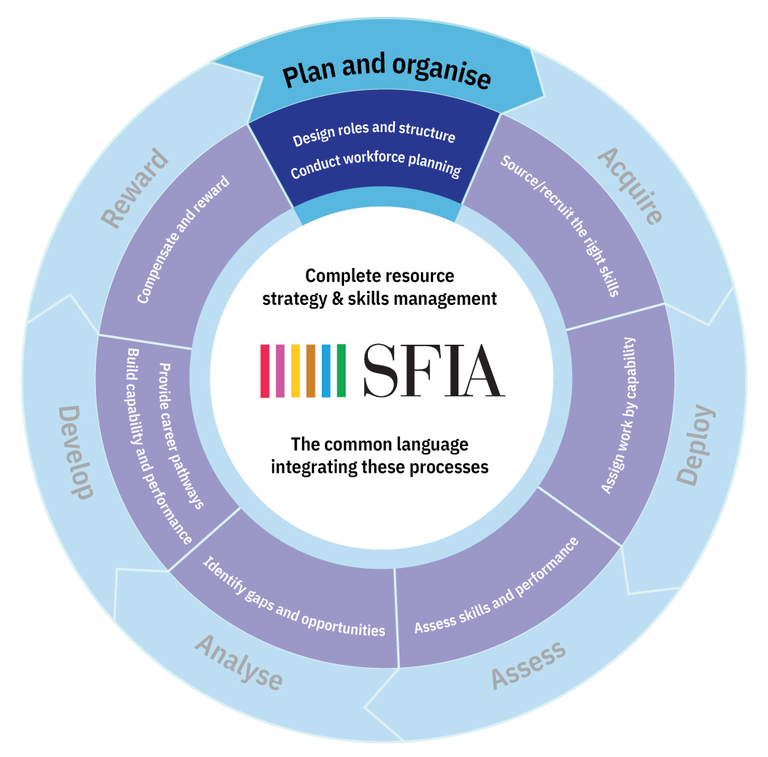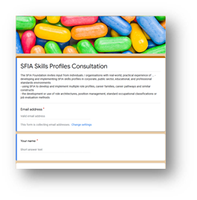
SFIA Skills profiles - sharing global good practice
The SFIA Foundation is launching a SFIA community initiative to identify and share recognised and generally accepted good practice in the area of SFIA skills profiles.
Scope
- methods used for the development and adoption of SFIA skills profiles
- classification and naming schemes for SFIA skills profiles
- publication of a set of SFIA skills profiles aligned to common, industry-standard jobs/role
Here, we use the term "skills profile" to refer to a mapping of the skills required for a position, job or role. It is not referring to an assessment and description of the skills which an individual Practitioner possesses.
E.g. A SFIA skills profile can identify and describe the SFIA skills and skill levels required for a position called “Software Developer”.
Invitation to Contribute
- The SFIA Foundation invites practitioners to contribute to this user community initiative.
- Typically, the most valuable contributions are tried and trusted approaches, guidelines, methodologies, tools which support the development and implementation of SFIA skills profiles.
- This input will be used to extract and identify recognized and generally accepted good practice. This will be generic – it will not be limited to specific apps, technologies or tools.
- Contributors may also wish to submit particular use cases or potential use cases for which guidance on the use of SFIA would be valuable – especially use cases not described elsewhere in this document
Participation enables your views to be recognised and for you to be involved in creating a valuable resource for the global SFIA community.
This initiative is endorsed by the SFIA Foundation and the SFIA Council.
Thanks in advance for your interest and support. If you have any additional questions or ideas please contact the SFIA Updates Manager.
Background
The SFIA user community (particularly new adopters) has always had an interest in using a trusted set of SFIA skill profiles ...
- The primary requirement is to have access to a pre‑defined set of SFIA skills profiles - aligned to common, industry-standard jobs/roles
- This would then save time and effort in adopting SFIA
A number of governmental bodies have produced standard profiles which have been mapped to SFIA skills and competency levels (UK Government DDAT, Australian Public Service, EU-ICT profiles)
One of the key design principles of SFIA is that it describes skills and competencies, not jobs. SFIA skills profiles are aligned to job responsibilities - not to a job title.
As a result, the SFIA Foundation has not created its own standard SFIA skills profiles. This is for two important reasons ...
- Job responsibilities need to be aligned to employers' organisation structures and role design. So a SFIA skills profile should be created to match the specific context and organisation design of the employer.
- the value which SFIA adopters get by creating their own skills profiles - achieved by a hands-on activity to understand the principles and content of the framework. This helps users achieve and sustain long-lasting benefits from SFIA skills profiles
However - SFIA has an extensive global use and a continuous flow of new users.
- This has inevitably meant an increase in the demand for good practice guidance.
- This interest comes from individuals, employers, professional bodies, educational establishments, national and international bodies.
- They want to use SFIA (the de-facto global standard) to support a wide range of skills management activities.
- SFIA skills profiles are a key component of many of these uses (see Use Case section below).
Open consultation
- The content of the SFIA framework is regularly updated through a global open consultation process. The SFIA Foundation will use a similar approach for this initiative.
- To do this we invite input from individuals/organisations with:
- real-world, practical experience of developing and implementing SFIA skills profiles in corporate, public sector, educational, and professional standards environments
- experience of using SFIA to develop and implement multiple role profiles, career families, career pathways and similar constructs
- experience of developing and/or using role architectures, position management, standard occupational classifications or job evaluation methods
- Examples you are familiar with from other organisations are also useful, though we would need to know which organisation it came from for proper attribution of the content.
- The consultation and initial deliverables will be in English – but examples in other languages are very welcome
- Translations of deliverables to other languages will be dependent on there being enough demand and the availability of resources for translation
- The published output will vendor-neutral. Once published, there will be an opportunity for SFIA users, partners and consultants to demonstrate that they do follow Recognized and Generally Accepted Good Practice.
Please do not submit material which you are not willing/able to share publicly or which the SFIA Foundation cannot use. This is to avoid any confusion over the source of the material and to make sure we only publish material which is publicly available to all.
Use Cases for SFIA skills profiles
“SFIA-based role profiles, job descriptions and skill profiles are probably the most common use of SFIA in organisations” and are used across the skills management cycle. From SFIA 7 The complete reference.
Example use cases mapped to SFIA skills management cycle
- Plan and organise – organisation design, TOM development, job descriptions, role profiles, generic professional profiles, workforce planning, position/role analysis, organisational capability-skills mapping
- Acquire - sourcing and recruitment of the right skills, staff augmentation or supplier engagement
- Deploy – assigning the right people with the right skills, resource pools, agile working practices, providing opportunities to develop new skills and experiences, divestiture/severance
- Assess – organisational capability assessment, supporting learning needs analysis, career planning, career development conversations, performance discussions, applying for jobs, writing a CV / resume, apprenticeship schemes, industry placement assessment as part of a degree-level qualification
- Analyse – for individuals and organisations, organisational capability gaps, re-skilling programmes, organisation design option, sourcing options, location options
- Develop - align development objectives to roles and jobs, providing clarity on the targeted levels of competence, understand the relevance of qualifications and certifications, make targeted investment in training and education
- Reward – support for job evaluation, job grading and salary benchmarking
